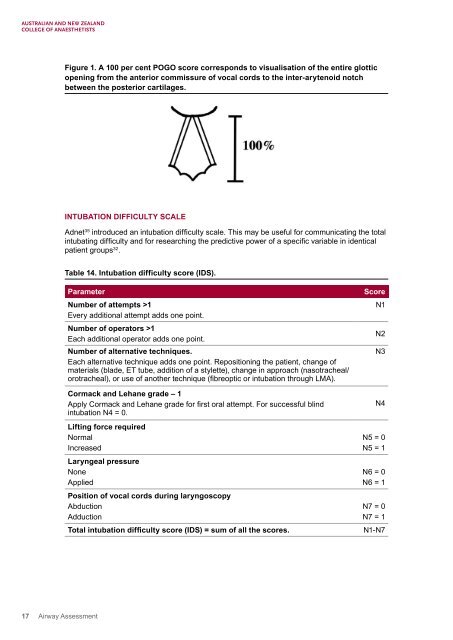Airway Assessment
2cKbSEQ
2cKbSEQ
Create successful ePaper yourself
Turn your PDF publications into a flip-book with our unique Google optimized e-Paper software.
Figure 1. A 100 per cent POGO score corresponds to visualisation of the entire glottic<br />
opening from the anterior commissure of vocal cords to the inter-arytenoid notch<br />
between the posterior cartilages.<br />
INTUBATION DIFFICULTY SCALE<br />
Adnet 35 introduced an intubation difficulty scale. This may be useful for communicating the total<br />
intubating difficulty and for researching the predictive power of a specific variable in identical<br />
patient groups 32 .<br />
Table 14. Intubation difficulty score (IDS).<br />
Parameter<br />
Number of attempts >1<br />
Every additional attempt adds one point.<br />
Number of operators >1<br />
Each additional operator adds one point.<br />
Number of alternative techniques.<br />
Each alternative technique adds one point. Repositioning the patient, change of<br />
materials (blade, ET tube, addition of a stylette), change in approach (nasotracheal/<br />
orotracheal), or use of another technique (fibreoptic or intubation through LMA).<br />
Cormack and Lehane grade – 1<br />
Apply Cormack and Lehane grade for first oral attempt. For successful blind<br />
intubation N4 = 0.<br />
Lifting force required<br />
Normal<br />
Increased<br />
Laryngeal pressure<br />
None<br />
Applied<br />
Position of vocal cords during laryngoscopy<br />
Abduction<br />
Adduction<br />
Total intubation difficulty score (IDS) = sum of all the scores.<br />
Score<br />
N1<br />
N2<br />
N3<br />
N4<br />
N5 = 0<br />
N5 = 1<br />
N6 = 0<br />
N6 = 1<br />
N7 = 0<br />
N7 = 1<br />
N1-N7<br />
17 <strong>Airway</strong> <strong>Assessment</strong>


